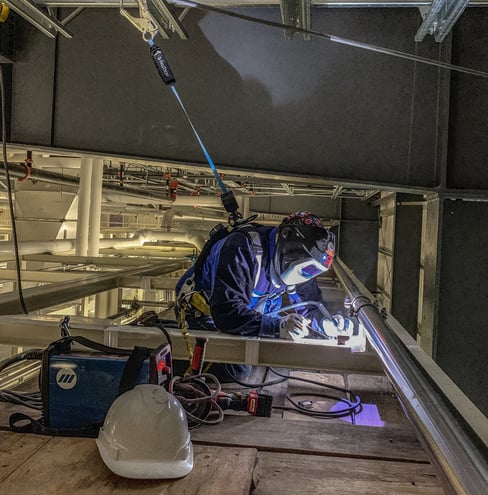(Updated 2024)
In any industry, complying with industry regulations ensures that your workplace is safe for your employees. Understanding the various standards and agencies involved in fall protection, however, can be tricky.
This article will walk you through the differences between OSHA and ANSI, what they mean for fall protection, and how you can maintain a safe and compliant work environment.
Table of Contents
What are the differences between OSHA and ANSI?
 The Occupational Safety and Health Administration (OSHA) and the American National Standards Institute (ANSI) are both organizations that exist to improve workplace safety. The standards and regulations these agencies create to ensure that companies actively protect workers from hazards.
The Occupational Safety and Health Administration (OSHA) and the American National Standards Institute (ANSI) are both organizations that exist to improve workplace safety. The standards and regulations these agencies create to ensure that companies actively protect workers from hazards.
Although they both have similar goals, their functions and operations are very different.
How do OSHA and ANSI function differently in the market?
OSHA is a federal government agency that regulates and enforces health standards and workplace safety regulations in companies throughout the U.S. Its work is mandated by the Occupational Safety & Health Act of 1970, also known as the OSH Act. OSHA regulations are U.S. law and you must follow them to avoid penalties.

ANSI, on the other hand, is a non-profit organization focused on coordinating and approving voluntary national consensus standards in the U.S. This organization works directly on the front lines to find the best ways to develop standards that improve workplace safety. Its team stays up to date with new technology and works hand-in-hand with manufacturers. It also partners with both insurers and the industry to push safety compliance.
ANSI isn’t a government agency. It is a voluntary consensus standards organization. ANSI represents industry best practices. In some cases, companies do not have to legally comply with its standards and compliance is not compulsory, however, in other cases they are. In fact, OSHA sometimes adopts or refers to ANSI standards in its own codes. If a law includes a reference to an ANSI standard, that standard is now considered law. The non-profit’s work may also be used to write new legislation. If the federal or state government uses the language from ANSI standards to create a law, the government can now legally enforce the standards. The two organizations also work together to improve standards and legislation. ANSI provides expert assistance to OSHA’s standards advisory committees to ensure new laws reflect reality. In return, OSHA lets ANSI know about any activities related to hearings, proposals, and final rulings for the development of new standards.
Why is it important to comply with ANSI and OSHA?
ANSI standards are viewed as implicit regulations. These regulations are not explicitly stated as laws, but occur either directly, as the result of litigation, or indirectly, after ANSI publishes its safety standards. Since the agency is an expert in consensus safety and industry standards, its codes are considered best practices. If you don’t follow them, you may inherently create liability for your organization.
How does this work?
OSHA’s general duty clause requires employers to maintain a workplace free from recognized hazards. When ANSI publishes a standard that includes specific actions that an employer should take to mitigate a particular hazard, it’s unlikely that an employer can reasonably claim ignorance regarding the potential dangers of that hazard. From a reasonable person’s perspective once ANSI publishes a market consensus standard, it may be legally interpreted as implicit to the health and safety protocols within the industry. That said, compliance with ANSI codes is not compulsory. If, however, these codes are made into law, as mentioned above, OSHA then has the authority to enforce the law for any non-compliance.
The aforementioned General Duty Clause is Federal law.This regulation requires employers to create a workplace that is free from all recognized hazards that are causing or may cause death or serious harm. This includes any circumstances where the employer can likely prevent or reduce the severity of any injuries to its employees. If OSHA classifies the hazards as recognized, it can cite the company for failing to meet its General Duty Clause. Depending on the situation, OSHA may reference ANSI standards in the citation.

Can fall protection equipment manufacturers achieve ANSI Z359 compliance while selectively complying with the standards?
No, they can’t per section 1.2.2 of ANSI Z359.1 “Before any product shall bear an ANSI/ASSP Z359 marking or be represented in any way as being in compliance with any ANSI/ASSP Z359 standard, the requirements of the associated product standard shall be met.”
Ensure your OSHA and ANSI compliance with FallTech
Using the correct PFAS (personal fall arrest system) is essential for a safe environment when working at height. Explore our products or get in touch with our knowledgeable sales team to find the right fall protection equipment your team needs today.
Body Wear
Anchorages
Lanyards
SRLs
Confined Space
Systems
Tool Tethering
Rescue and Descent
Kits
Utilities




